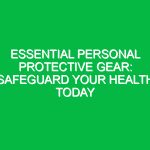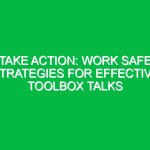Introduction
In the realm of Health, Safety, and Environment (HSE), personal protective equipment (PPE) serves as a critical line of defense against workplace Hazards. The Personal Protective Equipment PPE list encompasses a variety of gear designed to protect workers from potential risks, whether they are exposed to chemical substances, physical Hazards, biological agents, or environmental dangers. Understanding and implementing an effective PPE list is not just a regulatory requirement; it is a fundamental aspect of promoting a safe and healthy work environment. In this article, we will delve deep into the essential components of a Personal Protective Equipment PPE list, explore its relevance in HSE, and provide actionable insights for protecting your team effectively.
The Importance of Personal Protective Equipment in HSE
PPE is more than just gear; it is a Safety culture embedded within organizations. The proper use of PPE can significantly reduce workplace injuries and illnesses. For example, in a construction setting, a hard hat protects against falling objects, while Safety Goggles shield the eyes from harmful debris. The integration of PPE into the daily routines of workers not only complies with Safety Regulations but also fosters a sense of responsibility and care for oneself and colleagues.
Moreover, the ongoing COVID-19 pandemic underscored the importance of PPE in safeguarding health. Masks, gloves, and face shields became everyday items, highlighting how quickly workplaces must adapt to new health threats. This has led to a reevaluation of PPE Standards across various industries, emphasizing the need for comprehensive PPE lists that address both traditional and emerging hazards.
Key Components of a Personal Protective Equipment PPE List
To ensure safety in the workplace, a well-rounded personal protective equipment PPE list should include the following essential categories of gear:
1. Head Protection
Head protection is crucial in environments where there is a risk of falling objects or head injuries. Hard hats are the most common form of head protection, designed to absorb impact energy. Here are some key points to consider:
- Ensure hard hats meet ANSI/ISEA Z89.1 standards.
- Inspect hard hats for cracks, dents, or damage regularly.
- Provide head protection suitable for specific tasks, such as electrical work.
2. Eye and Face Protection
Eye and face protection is vital in preventing injuries caused by flying particles, chemical splashes, and hazardous light. Safety goggles and face shields are two common types of protective eyewear. Consider the following:
- Use Safety Glasses with side shields for general tasks.
- Choose goggles for chemical handling or dusty environments.
- Ensure face shields are worn in conjunction with safety glasses when necessary.
3. Hearing Protection
Excessive noise exposure can lead to irreversible hearing loss. Hearing protection devices, such as earplugs and earmuffs, are essential in noisy environments. When selecting hearing protection, keep these points in mind:
- Assess noise levels using a sound level meter.
- Choose hearing protection that provides adequate noise reduction based on exposure levels.
- Train workers on the proper use and Maintenance of hearing protection.
4. Respiratory Protection
Respiratory hazards, such as dust, fumes, and gases, necessitate effective respiratory protection. The selection of masks or respirators depends on the specific hazards present. Here’s what to consider:
- Conduct a risk assessment to identify airborne contaminants.
- Provide N95 respirators for particulate protection and full-face respirators for chemical exposure.
- Ensure proper fit testing and Training for all employees using respiratory protection.
5. Hand Protection
Hands are often exposed to various hazards, from cuts and abrasions to chemicals. Selecting the right gloves is crucial for ensuring safety. Consider the following:
- Match gloves to the specific hazards (e.g., cut-resistant gloves for sharp objects).
- Ensure gloves are free from defects and suitable for the task.
- Train employees on the importance of hand hygiene and proper glove use.
6. Foot Protection
Protective footwear is essential in preventing injuries from falling objects, slips, and punctures. Steel-toed boots are a common choice in construction and industrial settings. Important considerations include:
- Choose footwear with slip-resistant soles for wet or oily surfaces.
- Ensure proper fit to enhance comfort and safety.
- Inspect footwear regularly for wear and damage.
7. Body Protection
Body protection varies based on the nature of the work, including lab coats, coveralls, or specialized suits. Here are some principles to follow:
- Assess the type of exposure (chemical, heat, or biological) to determine appropriate body protection.
- Ensure that protective clothing fits well and allows for ease of movement.
- Implement guidelines for the proper cleaning and maintenance of protective clothing.
Potential Hazards and Safety Considerations
Understanding workplace hazards is essential for creating an effective personal protective equipment PPE list. Here are some common hazards to consider:
Chemical Hazards
In industries such as manufacturing and healthcare, workers may be exposed to harmful chemicals. Developing a PPE list that includes chemical-resistant gloves, goggles, and respirators can mitigate these risks effectively.
Physical Hazards
Construction sites, factories, and warehouses often expose workers to physical hazards, including falling objects and machinery. The use of hard hats, steel-toed boots, and high-visibility vests can significantly reduce these risks.
Biological Hazards
In healthcare settings and laboratories, biological hazards present significant risks. PPE such as gowns, gloves, and masks should be part of the PPE list to protect against exposure to pathogens.
Ergonomic Hazards
While not traditionally associated with PPE, ergonomic hazards can lead to injuries over time. Providing ergonomic training and equipment, such as supportive seating and adjustable workstations, complements the PPE list.
Best Practices for Implementing a Personal Protective Equipment PPE List
To ensure the effectiveness of your personal protective equipment PPE list, consider the following Best Practices:
- Conduct regular risk assessments to identify potential hazards.
- Involve employees in the selection process of PPE to ensure comfort and acceptance.
- Provide thorough training on the proper use, care, and maintenance of PPE.
- Implement a PPE program that includes regular inspections and replacements as needed.
Regulations and Standards Governing PPE
Compliance with regulations is a cornerstone of effective personal protective equipment management. Here are some key regulations that govern PPE in the workplace:
OSHA Standards
In the United States, the Occupational Safety and Health Administration (osha) sets forth regulations requiring employers to provide appropriate PPE to employees. Standards such as 29 CFR 1910.132 detail the responsibilities of employers in assessing hazards and providing suitable PPE.
ANSI/ISEA Standards
The American National Standards Institute (ANSI) and the International Safety Equipment Association (ISEA) provide guidelines for various Types of PPE. These standards ensure that equipment meets minimum performance criteria and provides adequate protection.
ISO Standards
Internationally, the International Organization for Standardization (ISO) provides standards relating to personal protective equipment, ensuring global consistency in safety practices.
Conclusion
The personal protective equipment PPE list is an indispensable element of any HSE strategy. By recognizing the importance of PPE and implementing a comprehensive list tailored to workplace hazards, organizations can significantly reduce the risk of injuries and illnesses. Investing time and resources into effective PPE management not only safeguards employees but also promotes a culture of safety and responsibility. As you consider your own workplace’s needs, remember that the health, safety, and well-being of your team should always be the top priority. Let this be a call to action: evaluate your current PPE practices and commit to fostering a safer work environment for everyone involved.


